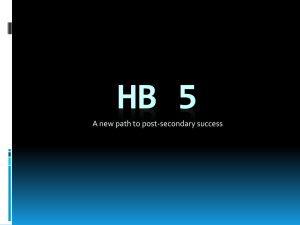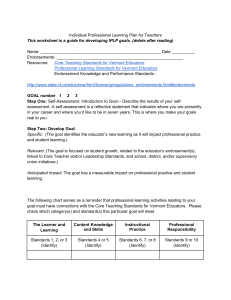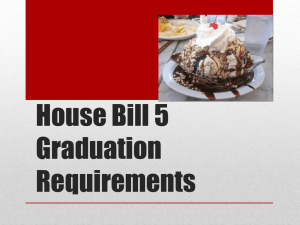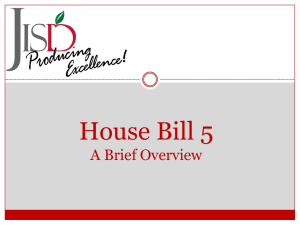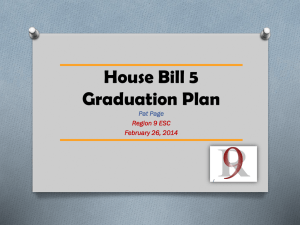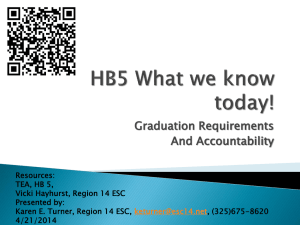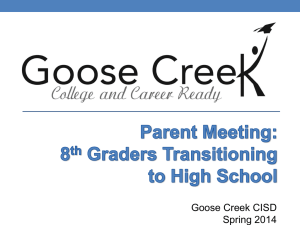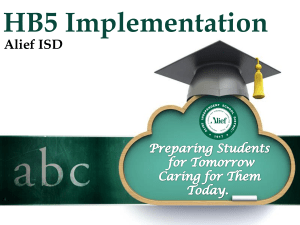March HB 5 FAQs - Region 10 Education Service Center
advertisement
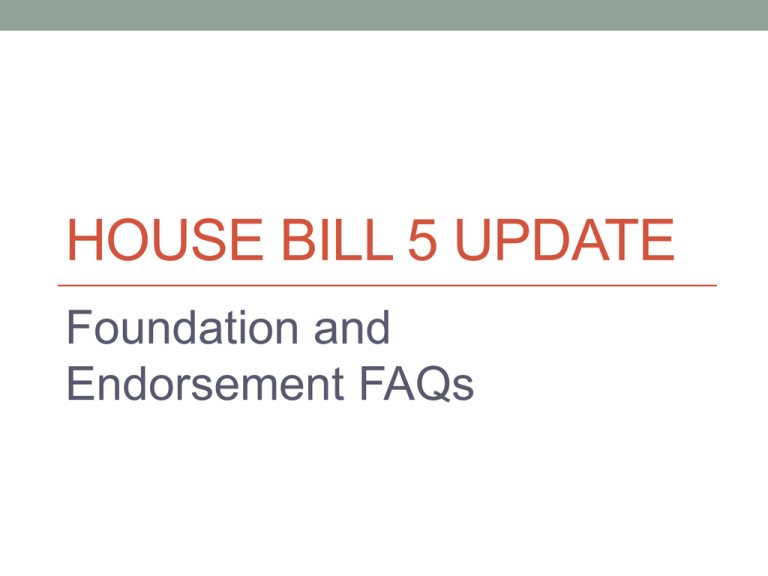
HOUSE BILL 5 UPDATE Foundation and Endorsement FAQs House Committee on Public Education Meeting: March 26 • Implementation of HB 5 and 3-8 assessments • Additional rigorous mathematics and science courses needed to address the current and projected needs of the state's workforce • Review the TEKS in the tested grades, • format, testing calendar, and the limitation on instructional days • Recommend options to streamline the assessment of TEKS to focus on core concepts • Review current federal testing requirements in grades 3-8 to determine if testing relief is possible Senate Education Committee Meeting: April 14 • Review the redesign of high school English EOC exams. • Review accommodations available as a result of the elimination of the STAAR-M • Review the redesign of the STAAR Alternate assessment. • Monitor implementation of HB 5 relating to • accountability, assessment, and curriculum requirements FOUDATION FAQS Foundation FAQs • A course may satisfy both a foundation and an endorsement requirement, including an elective. • Credit can not be given twice • If a student earns more than one credit for a course, any additional credit may be applied to an elective and/or endorsement requirement. Speech Skills • Each school district is responsible for ensuring that students demonstrate proficiency in the speech skills. • A district may require a speech course. This is a local decision. (Professional Communications, Comm. Apps.) Speech Skills • Documentation of a student’s demonstrated proficiency must be included on the Academic Achievement Record (AAR). Additional guidance will be provided in the revised Minimum Standards for the AAR. Math Models • Math Models may be offered first in the sequence of math courses. (2014-2015) • Math Models may be offered concurrently with Algebra I or geometry (2014-2015) • Algebra I will be a prerequisite for Math Models when the revised TEKS are implemented in the 2015-2016 school year. Science • The “second” science credit does not have to be taken before the “third” science credit. • No sequence implied in the rules or law • A student can take IPC after chemistry and/or physics LOTE • Computer Science I, II, and III may satisfy this requirement until September 1, 2016. • Can CTE computer programming courses satisfy the LOTE requirement? • No. At this time only Computer Science I, II, and III may satisfy this requirement. Caution!! • You can require more course work as a graduation requirement in your district, but you can not violate the SBOE rules or HB5 by changing the minimum requirements for the Foundation Plan or an endorsement. • There are not specific course sequence requirements however, districts should pay close attention to prerequisite requirements. Examples • LOTE – You can not require a student to take two or more years of the same language other than English, if they qualify for an option • Not even as a local requirement for graduation • Algebra II - You can not require a student to take Algebra II for the foundation plan or non-STEM endorsement • You can require Algebra II as a local graduation requirement outside of the above ENDORSEMENT FAQS Endorsements General • Rule: “This section does not entitle a student to remain enrolled to earn more than 26 credits.” • A student cannot continue to earn credits for endorsements indefinitely. • They can earn more than 26 credits, District decides when they have enough to graduate. Endorsements General • The district determines coherent sequence and identifies courses within that sequence. • The district determines the specific set of courses each student must complete to earn an endorsement • prerequisites must be followed • the set of courses meets the requirements of SBOE rule for that endorsement. Endorsements General • A school district may define advanced CTE courses • That course must be the third or higher course in a sequence. • The state list of “CTE Advanced” courses is not definitive Endorsements General • Career Preparation may be used as one of the courses in the coherent sequence • The final course in an endorsement sequence must come from one of the career clusters listed in the rule. Endorsements General Courses that could apply to two or more endorsements: • The district must determine which course is part of the coherent sequence of courses that a student takes. • The career cluster of that course would determine which endorsement the student earns. • This is a local decision. Endorsements General • A student may substitute an ELA, social studies, LOTE course, or fine arts course for 4th science credit required to earn an endorsement. • Need the written permission of the student’s parent STEM Option 5: Earn a STEM endorsement with “a coherent sequence of three additional credits.” • Students must take Algebra II, Physics, and Chemistry and three additional credits. from no more than two of the following categories: • The three additional credits must be a coherent sequence of courses from the required areas as determined by the local district. Public Services • A coherent sequence of courses may include courses from any CTE career cluster • The final course in the sequence is from one of the CTE career clusters under the public services endorsement • Districts determine if courses from different career clusters create a coherent sequence of courses Multidisciplinary Studies • Rule: A student may take “four advanced courses that prepare a student to enter the workforce successfully or postsecondary education without remediation”? • Each local school district has the authority to identify advanced courses. Things to think about? • How will districts address transfers where different courses are selected as advanced? • How will districts address transfers where different coherent sequences earn the same endorsement? Coming Soon! • Performance Acknowledgment FAQs • HB 5 FAQs on other components of the bill
